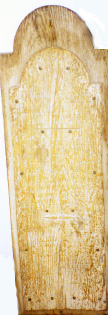A grave in the Falklands.
Episode: 36.
Site Number: 157.
Date Posted: 1 February 1997. Update 12 March 2000.
Location: Stanley, Falkland Islands.
Type: Grave.
James Weddell (1787-1834) is probably best known as the namesake of the Weddell Sea which he discovered in February 1823 on his third Antarctic voyage. In the same month he also set a 'furthest south' of 74 deg 15 ' S, 34 deg 16 ' W. His ship was the Jane; accompanying it was the Beaufoy, a 65-ton cutter whose master was Matthew Brisbane, a seafaring man of Perth.
Some years after this historic voyage Brisbane ended up in the Falkland Islands where he was in charge of the British settlement there. Things were in a confused state at the time and on August 26, 1833 Brisbane was
"attacked in his house by some of the Argentinians and Indians and was killed... His body, roughly buried by the Indians, was disinterred in 1842 by Captain James Clark Ross and reburied with a wooden headstone, inscribed:
'To the MEMORY of Mr. Matthew Brisbane who was barbarously murdered on the 26th August 1833. In the command of the Beaufoy Cutter he was the Zealous and able Companion of Captn James Weddell during his enterprising Voyage to beyond the 74th Degree of South Latitude in February 1823. His remains were removed to this spot by the crews of H.B.M. ships Erebus and Terror on the 25th August, 1842.'

 "This "headstone" is now in the museum at Stanley. It was replaced in 1933 by Sir James O'Grady, Governor of the Falkland Islands, by a simple marble slab bearing almost the same legend."
"This "headstone" is now in the museum at Stanley. It was replaced in 1933 by Sir James O'Grady, Governor of the Falkland Islands, by a simple marble slab bearing almost the same legend."
(Source: A. G. E. Jones, Notes & Queries 1971, reprinted in Polar Portraits, Whitby: Caedmon, 1992, pp. 111-13)
Update 12 March 2000: The original Brisbane marker is affixed to the back of the wooden reproduction, leaning against a wall in the Museum.

 "This "headstone" is now in the museum at Stanley. It was replaced in 1933 by Sir James O'Grady, Governor of the Falkland Islands, by a simple marble slab bearing almost the same legend."
"This "headstone" is now in the museum at Stanley. It was replaced in 1933 by Sir James O'Grady, Governor of the Falkland Islands, by a simple marble slab bearing almost the same legend."